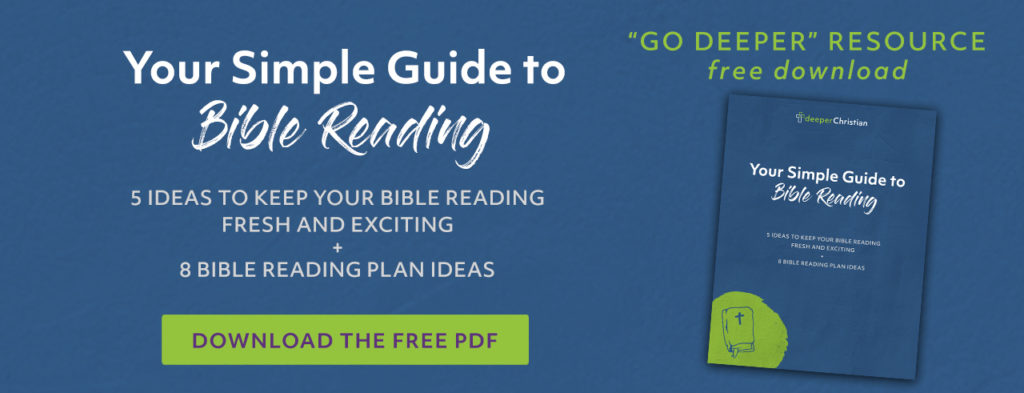
George Müller once said this about your involvement in the Bible: “The vigour of our spiritual life will be in exact proportion to the place held by the Bible in our life and thoughts.”
As a regular part of your Christian life, you need two important elements of engagement with Scripture:
- Bible Reading
- Bible Study
Bible Study
I’ve addressed Bible study in a variety of other articles—but my encouragement is that it doesn’t become merely a duty or something you check off a list, rather, let the Word of God be something you saturate in.
Bible Reading
Not only should you faithfully and diligently study God’s Word,
Remember: the reason we study and read the Bible is not merely to gain new information or facts … it is to know a Person (Jesus Christ) and to be transformed by Truth. If our time in the Word remains purely academic, we miss out on God’s desire—to draw us into greater oneness and intimacy with Himself through His Word.
If you struggle to keep your Bible reading alive, there are always ideas to keep your Bible reading fresh and exciting and different ways to read the Bible to get more out of it. But as Charles Spurgeon once wrote, the secret to enjoying your Bible reading is to read the Bible. Sure, it sounds simple, but don’t just take Spurgeon’s word for it, try it.
If you’re looking for a plan to get you started reading the Bible, here are several of my favorites.
7 Bible Reading Plans:
1. “One Year Bible” Method
There are some Bibles that are designed to be read this way, but you can simply read a selection (often a couple chapters) from the Old Testament, the New Testament, and a small portion of the Psalm and Proverbs. For example:
- Day One:
- Genesis 1:1-2:25
- Matthew 1:1-2:12
- Psalm 1:1-6
- Proverbs 1:1-6
- Day Two:
- Genesis 3:1-4:26
- Matthew 2:13-3:6
- Psalm 2:1-12
- Proverbs 1:7-9
Whether you use a “one year Bible” or create your own method, this can be a great way to peruse the entirety of Scripture in a year without getting bogged down in any one book.
2. Chronological
Obviously, the point of a chronological reading plan is to read the Bible chronologically—in order of when the events took place. As you get into the Old Testament histories, you’ll find yourself reading between 1-2 Samuel, 1-2 Kings, 1-2 Chronicles, and the prophets as the storyline of Israel unfolds.
You can find Bibles that are already laid out chronologically or you can find an online list of what to read in what order to read the Bible based on the timeline of Scripture.
I highly everyone to read the Bible through chronologically at least once since it can often give tremendous insight into the “how” and “why” certain events took place—when you see them in order.
3. Read the Bible Through in ___ Days
It may sound daunting, but reading the Bible through quickly can not only make it more exciting, but it can also help put pieces together that are often missed when you read slowly.
Consider reading through the entire Bible in 90 days (take the number of pages in your Bible, divide by 90, and you’ll know how many pages a day you’ll need to read). Though this will likely take 45-60 minutes a day, it is incredible rewarding.
If that is too intimidating to start with, try reading the New Testament through in 30 days (better yet, take 3-6 months and read it through once a month). You’ll be amazed at the insights you gain.
4. Read the New Testament Deeply
Imagine understanding the New Testament more deeply than you do now. What if you decided to read through a New Testament book once a day for an entire month (don’t let that scare you).
Reading through a book over and over allows you to see the flow, tone, and purpose of a book unlike anything else. Concepts are tied together that are missed when you only read it once.
For longer books (like Matthew with 28 chapters), you can split it up into chunks of 7 chapters (so Matthew would take you 4 months to read through). Otherwise, read the entire book through daily for 30 days. Here’s a plan:
- Read the Old Testament through each year (5-10 minutes a day)
- Read each New Testament book over and over (once or more a day) for an entire month (again, you can split longer books into several months of reading)
- In about 2.5 years, you will have read through the Old Testament 2.5 times and have done an in-depth reading of every New Testament book.
5. Gospel Immersion
This plan takes four months to complete but will give you a great grasp on the life of Jesus and the early church.
- Read Matthew as many times as you can for 2 weeks
- Read Acts as many times as you can for 2 weeks
- Read Mark as many times as you can for 2 weeks
- Read Acts again as many times as you can for 2 more weeks
- Read Luke as many times as you can for 2 weeks
- Read Acts again as many times as you can for 2 more weeks
- Read John as many times as you can for 2 weeks
- Read Acts again as many times as you can for 2 more weeks
6. Read Like George Müller
Rather than focus on how many chapters, this is more time based.
Start reading the Old Testament for however long you have time to read. When you finish for the day, place a bookmark. The next day, start the New Testament and read as far as you can in the time you have, then place a bookmark where you leave off. On the third day, go back to the Old Testament and pick up where you left off. Day four return to the New Testament, and so forth.
Simply, you go back and forth between the Old and New Testament for as long as you can each day.
George Müller read this way most of his Christian life and read the Bible through nearly 200 times by his death.
7. A Different Section of Scripture Each Day
However long you have time to read each week, focus each day on a different section of Scripture (place a bookmark or make a note of where you left off so on that day the next week you can pick up where you left off). Once you finish reading through that section, start back over—ie: on
- Monday: (Law) Genesis – Deuteronomy
- Tuesday: (History) Joshua – Esther
- Wednesday: (Poetry) Job – Song of Solomon
- Thursday: (Prophets) Isaiah – Malachi
- Friday: (Gospels) Matthew – John=
- Saturday: (remainder of New Testament) Acts – Revelation
- Sunday: you choose, special reading/study, etc
8. Robert Murray McCheyne Reading Plan
Robert Murray McCheyne, a Scottish minister who lived in the mid-1800s, put together a Bible Reading Plan where you read four chapters each day (one chapter from four different books of the Bible). In so doing, you read through the Old Testament once and the New Testament twice each year.
Countless Christians have used this plan and have enjoyed the reading rhythm, often finding amazing parallels between the different passages read on a particular day.
9. Audio Bibles
If you want to add a little variety to your Bible reading, try an audio Bible. They are available in most Bible translations and many also provide the choice between a single narrator or a dramatized version with an ensemble of voices (
Audio Bibles are great to listen to while driving, working out, or doing yard work—and keep your mind focused on God’s Word at the same time.
Additional Resources:
- Article: Why This Is The Best Time To Start A Bible Reading Plan
- Article: How to craft a plan to read the Bible
- Podcast: 5 Ideas to Keep Your Bible Reading Fresh and Exciting
- Podcast: 7 Bible Reading Plans to Help You Read God’s Word
- Podcast: Ten Ways to Read the Bible to Get More Out of It
- Other articles on deeperChristian about how to study and read the Bible

Disclosure of Material Connection: Some of the links in the post above are “affiliate links.” This means if you click on the link and purchase the item, deeperChristian will receive an affiliate commission (with no additional cost to you). It is a great way to support the work and ministry of deeperChristian. Regardless, we only recommend products or services we use personally and believe will add value to our readers. We are disclosing this in accordance with the Federal Trade Commission’s 16 CFR, Part 255: “Guides Concerning the Use of Endorsements and Testimonials in Advertising.”












